Low-Code and No-Code solutions for Public Sector
Low code and no code (LCNC) solutions are particularly well-suited for public…

Sacramento, CA – Radian Solutions, a leading provider of innovative technology solutions, is proud to announce that it has been awarded a significant Business Process Management (BPM) project by the California Department of Public Health (CDPH). The project focuses on enhancing the efficiency and effectiveness of the financial management processes through comprehensive process analysis and improvement.
Radian Solutions is committed to delivering high-quality outputs, including work plans based on CDPH requirements, written “as-is” process maps, recommendations, reports, updates, and project documentation based on current CDPH standards.
“We are honored to have been selected by the California Department of Public Health for this important BPM project,” said [Name], CEO of Radian Solutions. “Our team is excited to leverage our expertise in process improvement and technology to help CDPH achieve greater efficiency and effectiveness in their budget management processes. This project aligns perfectly with our mission to provide innovative solutions that drive positive change for our clients.”
For more information about Radian Solutions and its services, please visit www.RadianSolutions.com.
About Radian Solutions
Radian Solutions is a leading provider of technology and consulting services, specializing in public sector IT products and services. With a focus on delivering innovative and sustainable solutions, Radian Solutions partners with clients to drive efficiency, enhance productivity, and achieve business goals.

Radian Solutions, an IT Consulting company offering innovative technology solutions, is excited to announce the launch of its newly redesigned website alongside a dynamic new logo, marking a significant milestone in the company’s evolution. The new website and logo reflect Radian Solutions’ commitment to staying at the forefront of the technology industry while enhancing the customer experience.
A New Digital Presence for Enhanced User Experience
The revamped website offers a clean, modern design, improved functionality, and easy access to essential information. It is designed to provide a more user-friendly experience and to effectively showcase Radian Solutions’ comprehensive range of services and solutions. The site’s intuitive navigation ensures that visitors can quickly find the information they need, whether they are on a desktop or a mobile device.
A Logo That Represents Our Future
Along with the new website, Radian Solutions is proud to unveil its new logo. The redesigned logo represents a more modern and dynamic Radian Solutions, symbolizing the company’s growth and forward-thinking approach. The redesigned logo represents our growth and transformation while maintaining the core values that have defined our brand for years. The new logo embodies our forward-thinking mindset and commitment to delivering innovative solutions.
Commitment to Excellence and Innovation
“Our new website and logo are more than just a fresh look. They are a reflection of our company’s commitment to innovation and excellence,” said Niranjan Hiras, President of Radian Solutions. “As we continue to grow and evolve, it’s important for our brand to reflect the cutting-edge solutions we provide to our clients. We are thrilled to step into this new chapter with a renewed spirit and a brand that speaks to our future.”
Explore the New Website
Customers and partners are encouraged to explore the new website at www.radiansolutions.com to discover more about Radian Solutions’ services, latest projects, and the impact the company is making in the technology sector.

Dear Employees, Partners, and Clients,
As the year draws to a close, I am filled with immense gratitude and pride as I reflect on the journey we have embarked upon together. Our company, specializing in IT Consulting, has witnessed remarkable milestones this year, and it is all thanks to the collective effort and dedication of each one of you.
To our valued employees, your unwavering commitment and innovative spirit have been the driving force behind our success. Your ability to adapt and excel in an ever-evolving technological landscape is nothing short of inspiring. You are the backbone of our company, and your contributions are deeply appreciated.
To our partners, your collaboration and support have been pivotal in our journey. Together, we have navigated challenges and seized opportunities, creating solutions that have not only propelled our growth but also significantly impacted the IT industry. Your partnership is a testament to what can be achieved through shared vision and cooperation.
To our clients, it has been an honor to serve you. Your trust in our services has enabled us to contribute to mission-critical projects that make a difference in our community and nation. We are proud to be a part of initiatives that harness technology for the greater good, and we look forward to continuing this meaningful work in the coming years.
We have made remarkable strides in expanding and renewing existing contracts this year. This achievement underscores the trust and satisfaction our clients have in our services, motivating us to continue delivering solutions that exceed expectations. These renewed partnerships are vital to our ongoing success and growth.
This year has also been significant in terms of winning new contracts. These victories are not just a reflection of our competitive edge but also of our team’s relentless pursuit of new opportunities and challenges. Each new contract represents a fresh avenue for us to showcase our expertise and further solidify our standing in the industry.
In addition to these accomplishments, I am excited to announce the expansion of our consulting services portfolio with the addition of value added reseller offerings, that includes IT hardware and software licenses. This strategic move is aligned with our vision to provide comprehensive and cutting-edge solutions to our clients. By integrating these products into our IT consulting services offerings, we are enhancing our ability to meet the diverse and evolving needs of our clients more effectively.
As we look towards the future, I am confident that the foundation we have built this year will propel us to greater heights. Our focus will remain on delivering exceptional value to our clients, nurturing our partnerships, and continuing to innovate in our field.
Thank you for your hard work, trust, partnership, and for being a part of this incredible journey. Together, we have achieved remarkable success, and I am eager to see what we will accomplish in the coming year.
Wishing you and your families a prosperous, healthy and fulfilling new year!
Sincerely,
Niranjan Hiras
President, Radian Solutions


Business Problem
The State Department is facing challenges in ensuring the reliability, performance, and quality of its policy-related applications and integrated systems. The current testing processes may not be sufficient to identify and address all potential issues, leading to potential risks in system functionality, user satisfaction, and regulatory compliance. Additionally, the testing methodologies may lack innovation and efficiency, resulting in longer testing timelines and increased costs. To address these challenges, the department seeks to enhance its testing framework by incorporating comprehensive testing strategies, including functional, system integration, stress/performance, regression, and user acceptance testing. The project aims to improve testing processes, adopt industry best practices, leverage appropriate technologies, and promote innovation in testing methodologies to ensure high-quality, scalable, and timely delivery of software solutions.
Proposed Solution
Radian Solutions proposed an approach to software testing, aimed at ensuring the quality, performance, and reliability of policy-related applications and systems.
Benefits & Impact
Radian Solutions’ involvement in this project offered several benefits and impacts:


Business Problem
The Health IT System is a critical component of the state’s healthcare program, designed to ensure accurate and efficient verification of home healthcare services. However, the complexity of the system, coupled with the need for compliance with industry standards and best practices, poses significant challenges. The department aims to mitigate risks associated with system implementation, ensure the quality of the solution, and enhance overall project management effectiveness.
Challenges & Concerns
Proposed Solution
The proposed solution offered by Radian Solutions for this project ensure that the products being built are right and that they are built correctly. The service involves assessing various aspects of the project’s work products, including their content, adherence to standards and best practices, quality, process improvements, and other considerations.
Key components of the proposed solution include:
Radian Solutions provided detailed and prioritized recommendations for rectifying deficiencies and improving processes and products, ensuring that the project’s outcomes are aligned with industry standards and best practices.
Benefits & Impact
Radian Solutions provided a comprehensive and structured approach to ensuring the success of the project through Independent Verification and Validation (IV&V) services.
Standards


Business Problem
The State department currently lacks a comprehensive and efficient system for creating, maintaining, and securing business intelligence reports and dashboards. This deficiency hampers the ability to provide timely and accurate information to stakeholders, comply with regulatory requirements, and support strategic initiatives.
The existing data management infrastructure is outdated and inefficient, leading to performance bottlenecks, limited data accessibility, and inadequate security measures. As a result, business users and report developers struggle to access relevant data, hindering their ability to make informed decisions and provide valuable insights. Additionally, the lack of integration between reporting tools and other applications further complicates the reporting process and limits automation capabilities.
To address these challenges, the department requires a solution that enhances its reporting capabilities, improves data management, and ensures data security. The solution must include the research, design, and implementation of appropriate Cognos data packages, development of reports, maintenance of data models, integration with external applications, and performance tuning. Additionally, it should provide education and knowledge transfer to users, manage software upgrades, and deliver regular status reports to management.
Proposed Solution
The proposed solution offered by Radian Solutions for the project includes the following components:
Benefits & Impact
Radian Solutions offered a comprehensive suite of benefits and impacts through this project, aimed at enhancing the efficiency, security, and effectiveness of data management and reporting systems.
Effective Project Management: Provided weekly status reports to management and attended project and team meetings ensured transparent communication and effective project management.
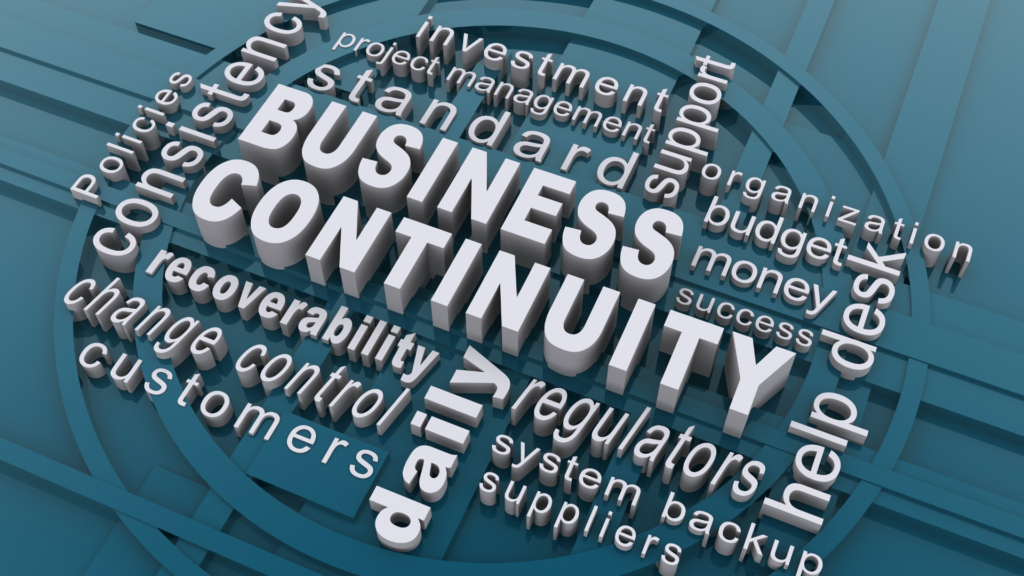

Business Problem
The State Department is facing a critical challenge in ensuring the resilience and continuity of its operations amidst potential disruptions. With the increasing reliance on information technology and the ever-evolving threat landscape, the State department is required to meet the stringent compliance requirements set by the Statewide Information Management Manual (SIMM) 5325B, as mandated by the California Department of Technology (CDT). However, the department currently lacks a comprehensive understanding of its vulnerabilities, the potential impacts of disruptions on its critical business processes, and the effectiveness of its recovery strategies.
The absence of a robust Business Continuity Plan (BCP), a thorough Gap Analysis, an in-depth Risk Assessment, and a detailed Business Impact Analysis (BIA) leaves the department exposed to significant risks. These risks include the inability to sustain business operations effectively, failure to meet compliance requirements, and potential financial and reputational damage.
To address this business problem, the State department seeks to engage a specialized contractor to develop and implement a BCP, conduct a Gap Analysis Report, develop a Risk Assessment Report, and create a BIA Report. The goal is to identify and mitigate vulnerabilities, enhance the continuity of critical business processes, and ensure compliance with SIMM 5325B standards. This will enable them to better prepare for, respond to, and recover from disruptions, thereby minimizing business impacts and sustaining effective operations.
Proposed Solution
Radian Solutions proposed a phased approach to implementing the BCP program and to mature the BCP program over time.
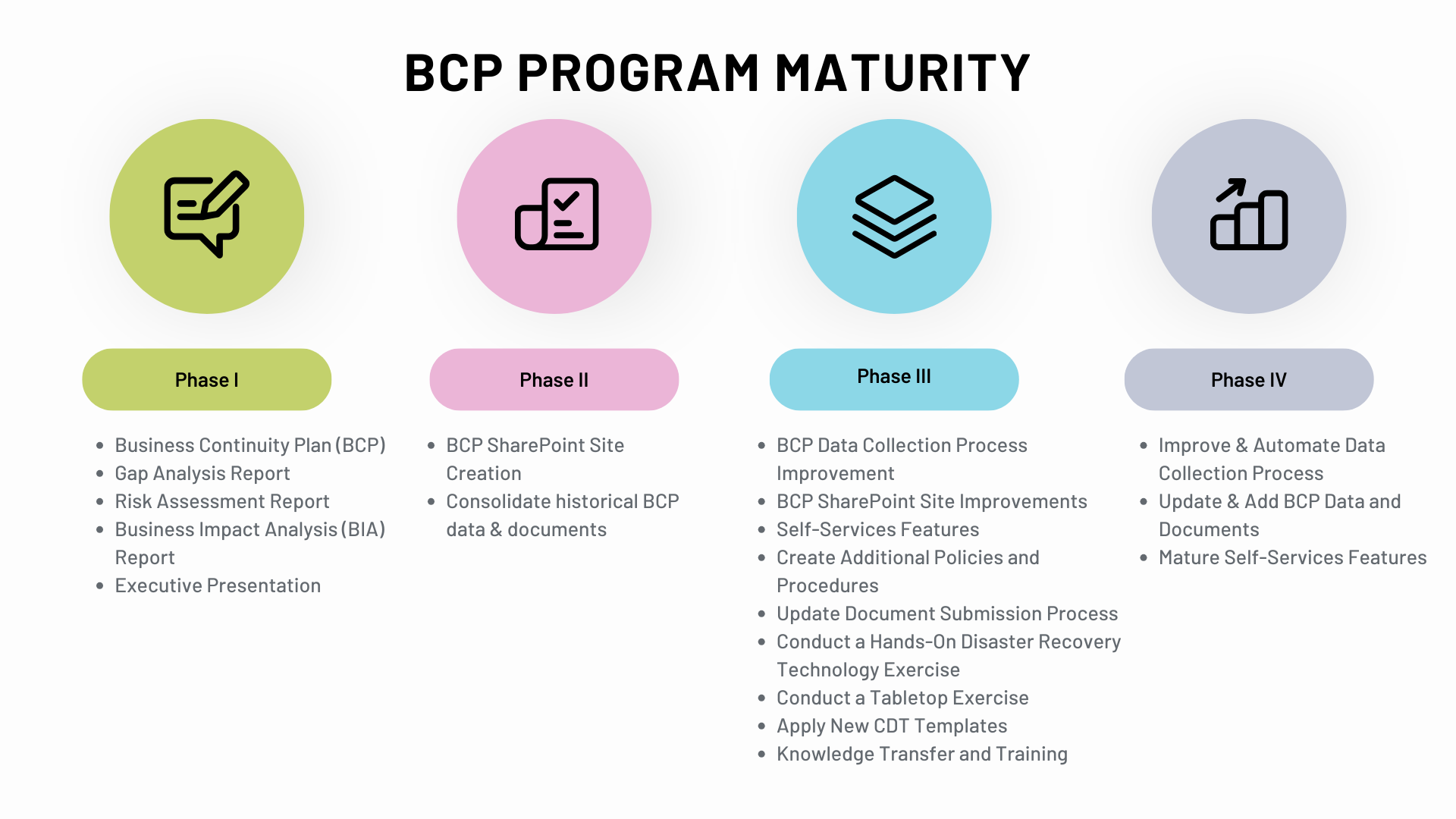
Phase I
The proposed solution offered by Radian Solutions for the State department includes the following key components:
Phase II
Phase III
The proposed solution offered by Radian Solutions for the State Department to enhance its Business Continuity Plan (BCP) program includes the following key components:
Phase IV:
Benefits & Impact
Implementing and maturing a BCP program for the State department offered several benefits:
Self-Service Features for Divisions and Projects:
BCP Data Updates Automation:
Simplify Annual SIMM 5325B Process:
Overall, these features and improvements contribute to a more efficient, effective, and user-friendly BCP process. They empower divisions and projects to take greater control over their BCP data, automate routine tasks to save time and reduce errors, and simplify compliance with annual regulatory requirements, ultimately enhancing the organization’s resilience and preparedness for potential disruptions.


Business Problem
In this digital age, the federal agency faces a critical challenge of modernizing its contract management and operational processes to enhance efficiency, reduce costs, and improve service delivery. Despite the legal acceptance of electronic signatures as formalized by the Electronic Signature in Global and National Commerce (ESIGN) Act of 2000, the federal agency’s current reliance on paper-based signing processes for contractual agreements with vendors represents a significant bottleneck. This outdated approach not only slows down the execution of contracts but also increases operational expenses and impacts their ability to respond swiftly to market and regulatory changes.
The transition to electronic and digital signature usage is not merely a technological upgrade but a strategic necessity to align the agency’s operations with contemporary digital standards. This shift promises to eliminate the dependency on physical paperwork, streamline business processes, and position the federal agency as a leader in digital modernization and governance. However, the integration of digital signature technology into agency’s existing systems, applications, and platforms (including Appian, Salesforce, Google, and legacy systems) presents a complex set of technical, operational, and user adoption challenges. These challenges include ensuring system compatibility, maintaining security and legal compliance, managing change within the organization, and providing adequate training and support to both internal staff and external partners.
To address these challenges, the federal agency required a contractor capable of leading the integration, development, testing, training, and implementation support for the digital signature solution. The contractor must possess deep technical expertise in digital signature technologies, a strong understanding of agency’s operational context, and the ability to work collaboratively with various stakeholders to ensure a seamless and successful transition to digital processes. The ultimate goal is to achieve a fully digital, paperless business environment that enhances agency’s operational efficiency, reduces costs, and delivers improved services to its constituents, thereby supporting agency’s strategic objectives of digital transformation and operational excellence.
Proposed Solution
As a subcontractor, Radian Solutions led this project and proposed a comprehensive and strategic approach to support the federal agency in its transition to a fully digital and paperless business process environment, leveraging electronic and digital signatures to streamline operational efficiencies, reduce costs, and enhance service delivery. Radian Solutions worked with and led prime vendor’s team to implement the proposed solution that encompassed several key components designed to address the technical, operational, and user adoption challenges associated with integrating digital signature technology across agency’s diverse systems and platforms.
Strategic Planning and Requirements Gathering:
System Integration and Development:
Business Process Re-engineering:
Training and Mentorship:
Documentation and Compliance:
Security and Reliability:
Radian Solutions (subcontractor), as the lead and architect on this project, offered a state-of-the-art digital signature solution that aligns with agency’s strategic goals of digital transformation and operational excellence. Our approach combines technical expertise, strategic planning, and user-centric design to ensure a successful transition to a digital-first environment, enabling the agency to achieve its objectives of efficiency, cost reduction, and improved service delivery.
Benefits & Impact
The transition to electronic and digital signatures represents a significant step forward for the agency, offering numerous benefits and impacting various aspects of its operations.

In conclusion, the adoption of electronic and digital signatures at the federal agency is a forward-thinking initiative that promises to modernize contractual processes, reduce costs, improve efficiency, and foster a more secure and environmentally friendly approach to document management. This transition not only aligns with federal mandates but also sets a precedent for digital innovation within the agency and across the federal government.
Standards & Frameworks


Problem Statement
The problem centers on the need for a specialized SharePoint Programming Services to support and enhance the implementation and utilization of SharePoint Online, Nintex for Office 365 workflows, Microsoft Flow, and DocuSign within the State departments’ IT environment. Despite previous engagement with a vendor for support services, the State Department faces challenges due to the diverse and complex requirements of its divisions and project teams. The overarching issue involves the need for additional services to develop, support, and modify custom solutions and manage the integration and effective use of these technologies across the organization. The State Department needed vendor support to ensure their projects and divisions adhere to the department’s SharePoint Governance Plan while providing comprehensive support including development, customization, administration, training, and documentation to facilitate seamless workflow automation, document management, and overall project management within the department’s management framework.
Solution Overview
Radian Solutions’ proposed solution for this project included a comprehensive strategy tailored to ensure the successful implementation and support of SharePoint Online, Nintex for Office 365 workflows, Microsoft Flow, and DocuSign as enterprise tools within the State department’s framework. Our proposal outlines a detailed approach to achieve the objectives set forth in the SOW, emphasizing collaboration, customization, and knowledge transfer to ensure State Department’s projects and divisions are well-equipped and compliant with the State department’s SharePoint Governance Plan.
Radian Solutions’ approach is designed to be collaborative, flexible, and tailored to the State department’s specific requirements, ensuring that the implementation of SharePoint Online, Nintex, Microsoft Flow, and DocuSign not only meets but exceeds expectations for enhancing productivity, collaboration, and operational efficiency.
Benefits & Impact
Partnership with Radian Solutions has offered several benefits and impacts that align with State department’s strategic objectives for improving its IT infrastructure and operational efficiency.
Benefits and Impact
In summary, the partnership with Radian Solutions has provided the State department with a robust, efficient, and flexible IT environment that supports its operational and strategic objectives, while also ensuring that staff are well-equipped to manage and utilize the new systems effectively.
Standards & Frameworks
Solutions offered


Business Problem
A State of California department needed support to run their EBT program that included technical and financial reconciliation services to support program and system development, maintenance, and support. The objective was to automate the issuance, delivery, redemption, settlement, and reconciliation of food and cash public assistance benefits in California, which is unique in its decentralized administration across 58 counties. State department needed consultant services who would be responsible for various tasks including system maintenance and operations, integration of system changes and new functionality, data repository and data analytics, support for the procurement and transition to a new EBT system, knowledge transfer, planning for the end-of-contract changeover and any unanticipated tasks that may be needed.
Proposed Solution
Radian Solutions’ proposed solution for this project involves providing technical and financial reconciliation services to develop, maintain, and support the program and the system for the California State Department. The key components of their solution include:
Overall, Radian Solutions’ proposed solution aims to ensure the effective operation and maintenance of the IT System, support the integration of new functionalities, and facilitate the transition to the new California EBT system.
Benefits & Impact
Radian Solutions offered services to manage the State’s EBT Program that offered several benefits and impacts:
Overall, the proposed solution aims to enhance the efficiency, accuracy, and security of the benefit distribution process in California, while also providing a robust system for managing and reconciling financial transactions associated with public assistance benefits.
Frameworks
Technology Stack


Business Problem
The State Department needed to enhance its data protection capabilities in response to evolving security threats and compliance requirements. Despite existing measures, the State Department faces challenges in effectively managing and securing sensitive data across its diverse IT environments, including on-premises and cloud applications. The complexity of IT infrastructure, coupled with the stringent compliance standards it must adhere to, necessitates a comprehensive approach to data loss prevention (DLP) that can adapt to changing business processes, regulatory landscapes, and emerging security vulnerabilities.
Key Challenges:
Proposed Solution
The proposed solution offered by Radian Solutions for this project focuses on enhancing the State Department’s Data Loss Prevention (DLP) capabilities, ensuring compliance with relevant standards, and securing sensitive data across various platforms and cloud services. This comprehensive approach includes a series of tasks designed to review, refine, and implement DLP policies, configurations, and system upgrades, as well as to provide essential documentation and knowledge transfer.
Here’s a breakdown of the proposed solution across the project’s phases:
This solution is aimed at fortifying the State department’s defenses against data loss, ensuring compliance with standards, and enhancing the security posture of State department’s IT environment through strategic DLP policy management and system enhancements.
Benefits & Impact
The completion of the project by Radian Solutions, as outlined in the scope of services, provides several benefits and impacts for the State agency:
Overall, the completion of this project significantly strengthens the State Department’s ability to protect its sensitive data, comply with regulatory standards, and respond effectively to security incidents, ultimately enhancing its overall cybersecurity posture.


Business Problem
To enhance the overall functionality of the Statewide IT Human Service system, there is a critical need for specialized services in the following areas:
Application Lifecycle Management (ALM) Development and Training:
Requirements Management Development and Process Improvement:
Testing Support and Training:
Proposed Solution
Radian Solutions offered a comprehensive solution to assist the State department during a period of heavy workload, support services for all three primary roles focusing on different aspects of the project:
Benefits & Impact
The benefits and impact provided by Radian Solutions on this project are significant and multifaceted. They include:
Overall, the services provided by Radian Solutions will have a significant positive impact on the State project, ensuring that it is well-equipped to handle the heavy workload and deliver a high-quality system that meets the needs of its users.


Business Problem
The State of California agency was facing several challenges with its existing time reporting and work activity tracking application, which is a legacy time management system. The limitations and inefficiencies of the legacy time management system were impeding the agency’s ability to effectively manage payroll, leave accounting, and work activity for its diverse workforce. The inadequacies of the current system also hinder the department’s ability to meet external human resources, budget, and accounting reporting requirements. Furthermore, the integration of the legacy time management system with other internal data sources is not optimal, leading to potential data integrity and usability issues.
Consequences of not upgrading
If these problems are not addressed, the agency could face significant operational inefficiencies, increased risk of financial and reporting errors, and a lack of compliance with state regulations. This could result in decreased employee satisfaction due to payroll and leave accounting inaccuracies, reduced operational efficiency due to poor work activity tracking, and potential legal and financial repercussions from non-compliance with external reporting requirements.
The modernization project is critical to upgrade agency’s time reporting and work activity tracking capabilities, ensuring efficient and accurate payroll and work activity management, and compliance with state reporting requirements. This modernization is vital for improving overall operational efficiency, data integrity, and employee satisfaction within the agency.
Proposed Solution
Radian worked in partnership with the State agency in developing an enterprise time reporting, leave accounting, and work activity tracking application. The project leverages the Rational Unified Process (RUP) methodology for software development, ensuring a systematic, iterative approach to updating, developing, and maintaining the software solution.
Radian’s efforts on this modernization project encompasses several key technical components and tasks:
Benefits & Impact
This modern time management system offered a robust, integrated solution for agency’s payroll and work activity accounting. It facilitated efficient time reporting and leave accounting for all employees, align with external reporting requirements, and enhance data accuracy and accessibility. This comprehensive approach to time and activity management streamlines agency’s administrative processes, leading to increased operational efficiency and improved resource management. Specifically, implementation of modern time management system had a significant impact on agency’s operations:
In summary, the successful implementation of modern time management system greatly enhanced the effectiveness and efficiency of agency’s time reporting and work activity tracking. This not only improved internal operations but also positively impacted on employee satisfaction and compliance with regulatory requirements.
Frameworks
Technology Stack
Features
| Module | Feature |
| Financial Management | Manage Process Codes |
| Manage Program Codes | |
| Manage Project & Activity Codes | |
| Manage LD Code | |
| Accounting Codes Data Conversion | |
| Manage Work Activity | Create and Update Task Categories |
| Create and Delete Task | |
| Update Basic Task Details | |
| Update Task Effective Pay Periods & Volume | |
| Update Task Mapping | |
| Work Activity Planning | |
| New Task Request and Review | |
| Manage Employee | Create & Update Employee Profile |
| Assign PUCs to TK and PS | |
| Assign Divisions to FPU Role | |
| Create and Inactivate Team Names | |
| Search for EE | |
| Manage Backup Supervisors | |
| Submit EE Requests | |
| Approve and Deny EE Requests | |
| View and Upload Documents | |
| Assign Tasks | |
| Manage Timesheet (Data Entry / Update Timesheet) |
View Calendar |
| Build Flex Calendar | |
| Create Basic Absence Request | |
| Manage Usage Only Leave Type | |
| Create Usage Only Absence Request | |
| Authorized User Reviews Absence Request | |
| Viewing and Managing Timesheet | |
| Supervisor/Manager views team Absence Request Calendar | |
| Assign Overtime | |
| Post Overtime | |
| Post Holiday Overtime | |
| Post to Cover Regular or Holiday Deficit | |
| Work Excess to Cover Deficit | |
| Manage Timesheet | Generate e634 and e682 |
| Authorize e634 | |
| Authorize e682 | |
| View Status of e634 | |
| Perform Automatic Retroactive Changes | |
| Manage Time Activity and Tracking | Track Hours |
| Manage VPLP | |
| View, Print and Save Leave Accruals and Earns | |
| View Months of Service History | |
| Process Miscellaneous Transactions | |
| Finalize Pay Period | Unlock and Relock Pay Period and Perform Retroactive Changes (Manual) |
| Interface with internal systems | |
| Perform Calculations/Finalization | |
| Fi$Cal Cutoff Date and Time | |
| Interface with SCO for SCO CLAS File and INT Pay File | |
| Reports and Dashboards |

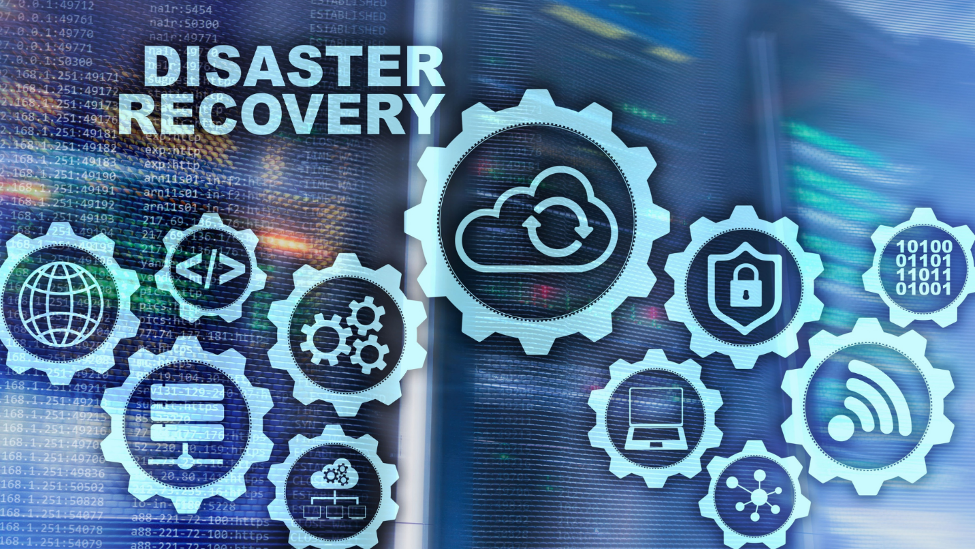
Business Problem
The State department currently lacks a comprehensive and robust Information Technology Disaster Recovery (ITDR) model that adequately protects its mission-critical systems against disasters and ensures business continuity. This deficiency exposes the State department to significant risks, including potential data loss, extended system downtime, and compromised operational capabilities, which can negatively impact the statewide mission-critical system and its dependent functions.
To address this critical issue, the department seeks a contractor to assist in establishing a systematic and resilient ITDR framework that aligns with the VMware Virtualization Platform. The objectives include designing an ITDR model, selecting and deploying suitable backup hardware and software solutions, building a remote Disaster Recovery (DR) site, updating existing backup/DR practices, producing operational manuals for the backup infrastructure, and mentoring the development staff to adapt to the new principles and practices.
The successful implementation of this project is essential to ensure the reliability, availability, and integrity of state department’s mission critical functions, ultimately safeguarding the continuous operation and effectiveness of their services to the citizens of California.
Proposed Solution
Radian Solutions’ proposed solution for the State Department’s disaster recovery project encompasses the following key components:
Deliverables:
Radian Solutions’ approach ensures a holistic and robust disaster recovery solution for the State Department’s mission-critical needs, focusing on resilience, rapid recovery, and knowledge transfer to empower the State staff to effectively manage and maintain the new systems.
Benefits & Impact
Radian Solutions’ services offered several benefits and made significant impact on the State department’s requirements for this project.
One of the key benefits offered by Radian Solutions is the mentoring and training of DWR development staff to understand the systems backup architecture and DR management principles and practices.
Our Knowledge Transfer Plan outlined the approach to transferring knowledge from Radian Solutions to the State staff, ensuring that the department’s objectives are met and that the team is equipped to manage the backup and DR systems effectively.
In summary, Radian Solutions can provide valuable expertise and a comprehensive approach to establishing systems disaster recovery processes, delivering a significant positive impact on the organization’s ability to protect and recover critical systems in the event of a disaster.
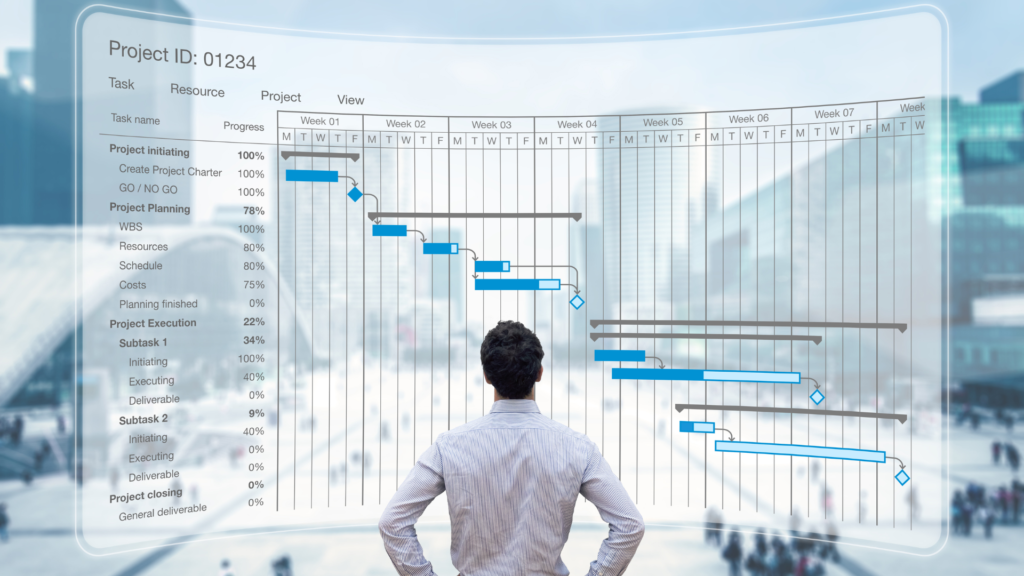

Problem Statement
A State of California department was facing significant challenges in managing the complex, multifaceted program, essential for consolidating and optimizing controlled substance data in California, requiring meticulous project management and procurement support across various stages of its California’s procurement lifecycle to secure funding and onboarding vendor for this project. The existing project management practices were not fully aligned with the California Department of Technology’s Project Management Framework (CA-PMF) and Project Approval Lifecycle (PAL), leading to potential inefficiencies, increased risks, and suboptimal utilization of resources. The absence of a comprehensive and standardized approach to project management could result in delays, budget overruns, and failure to meet the program’s objectives and stakeholder expectations. The department was seeking support in the following areas:
Solution Overview
To address the complex needs of the State of California Department, we proposed a robust and comprehensive project management solution that aligns with the California Department of Technology’s Project Management Framework (CA-PMF) and the Project Approval Lifecycle (PAL). This solution focuses on delivering expertise and structured processes across all phases of the project management lifecycle to ensure successful execution and completion of the Program requirements.
Key Components of the Solution:
Benefits & Impact
Radian Solutions offered services to manage the State’s Program and offered a significant step towards achieving operational excellence, compliance, and strategic success within the State Department. This initiative not only promises immediate project benefits but also lays the foundation for long-term organizational growth and development. Knowledge transfer and capability building will ensure that the State employees remain at the forefront of project management excellence.
Standards & Frameworks


The State Health and Human Services department is facing significant challenges in managing and processing post-adjudicated claims and encounters the existing system infrastructure requires substantial enhancements. These initiatives demand not only the expansion of system capabilities but also ensure its compliance with evolving data standards and healthcare regulations.
Business Problem
Proposed Solution
Our solution encompasses a range of services aimed at enhancing the capabilities to meet the requirements of new healthcare initiatives and ensure seamless operation and integration within the State department’s technological ecosystem.
Radian Solutions has provided the State department with a comprehensive, efficient, and sustainable IT solution. Our approach combines technical expertise, collaborative engagement, and a focus on capacity building to ensure the State not only meets current needs but is also poised for future challenges and opportunities.
Benefits & Impact
Radian Solutions brought a multifaceted array of benefits and impacts, encompassing improvements in system capabilities, compliance with regulations, and enhancements in data management and utilization.
In summary, the project not only aims to enhance the technical and operational capabilities of healthcare IT system but also seeks to ensure that the system can support current and future healthcare initiatives in a compliant, efficient, and scalable manner. This will have a lasting positive impact on the quality of healthcare data management and the ability to utilize this data for the benefit of the state’s healthcare system.
Standards & Frameworks


Business Problem
The healthcare system is a critical component of California’s healthcare infrastructure, providing essential services to the California citizens. It serves over 18,000 users, including state staff, counties, and healthcare providers, enabling them to manage patient eligibility, records, service provider authorizations, and system reporting. The system also facilitates the electronic submission and management of service authorizations.
However, this system is currently in maintenance mode, and there is an urgent need for continued maintenance and operations (M&O) to ensure its functionality and support. Any failure in these applications could have a significant impact on providers, government staff, and clients across all 58 counties in California. The system’s reliability is crucial for the management of medical case information and the timely provision of healthcare services to California’s most vulnerable citizens with special healthcare needs.
The business problem, therefore, is to ensure the continuous, reliable operation of this system by providing comprehensive technical support and application maintenance services. This includes addressing system “fixes,” program policy changes, incident reports, data repairs, change requests, software maintenance change requests, and compliance with HIPAA and state and federal statutes. Additionally, there is a need to maintain system operations, including capacity planning, performance monitoring, backup and recovery processes, technical support and monitoring administration. The system’s availability, help desk support, and adherence to performance service level agreements are also critical components of addressing this business problem.
Proposed Solution
The proposed solution offered by Radian Solutions for this healthcare project included program management and a comprehensive range of technical support and maintenance services. The scope of services included:
Overall, the proposed solution aims to ensure the continued operation, reliability, and security of the system, which is critical for managing medical case information for the Statewide Healthcare Program.
Benefits & Impact
The benefits and impacts offered by Radian Solutions for this project are summarized as follows:
Standards and Framework
Rational Unified Process (RUP)
Technology Stack
Java


Business Problem
A California State Department was tasked with the implementation of the Health Benefit Exchange (HBE) as mandated by federal and state regulations. This initiative aims to provide a single point of entry for beneficiaries and potential health insurance enrollees to access and sign up for health insurance. This requires the integration of various systems and the standardization and secure transmission of data between DHCS and external entities such as the Internal Revenue Service, Social Security Administration, and healthcare providers.
The project faces several challenges, including:
Proposed Solution
Radian Solutions addressed these challenges by establishing an Enterprise Business Architecture (EBA) which will guide the development of a model-driven approach to Business Process Management (BPM). This approach will integrate all business participants, automate processes, and provide a roadmap to meet federal and state mandates. The success of this project is critical to ensuring that the State of California can effectively meet the demands of the HBE initiative and provide accessible health insurance options to the public.
This solution is structured as a multi-phased project, with each phase subject to review and approval by state and federal control agencies. The key components of the proposed solution include:
Overall, Radian Solutions’ proposed solution aims to provide a structured and comprehensive approach to planning and implementing the HBE project, ensuring compliance with federal and state mandates and effectively managing the integration of various systems and processes.
Benefits & Impact
The completion of the first phase of the Health Benefit Exchange (HBE) project by Radian Solutions is expected to bring several benefits and impacts:
Overall, the successful completion of this project phase by Radian Solutions is expected to lay a solid foundation for the HBE system, enabling DHCS to better serve the health insurance needs of its beneficiaries while meeting compliance requirements and improving operational efficiency.
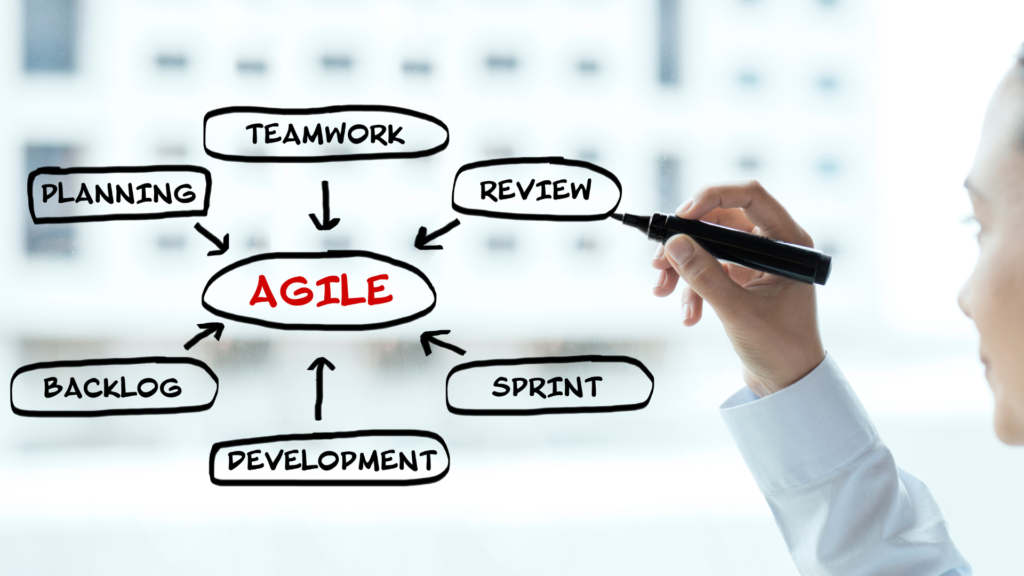

Business Problem
The State of California is undertaking significant technology projects, that are complex, involve multiple stakeholders, and require continuous design, development, and operation. To enhance the success of these projects. The State seeks to adopt Agile methodology across its business and technology teams, however, the transition to Agile presents several challenges:
To address these challenges, the State seeks to engage an Enterprise Agile Coaching Contractor to provide comprehensive Agile coaching services. The goal is to enhance the understanding and application of Agile methodology at all levels of the organization, support continuous technology design, development, and operation, and ultimately deliver projects that provide the most important business value efficiently and effectively.
Proposed Solution
The proposed solution offered by Radian Solutions for this project involves providing Enterprise Agile Coaching services to support the State department’s efforts. The scope of services includes:
The goal of Radian Solutions’ proposal is to enhance the understanding and utilization of Agile methodology at all levels of the organization, supporting continuous technology design, development, and operation. This involves a transformation of both mindset and practices, with a focus on teamwork, collaboration, iterative delivery, flexibility, continuous improvement, and delivering business value.
Benefits & Impact
The benefits and impacts of the Enterprise Agile Coaching services provided by Radian Solutions as described in the scope of services include:
Overall, the Enterprise Agile Coaching services provided by Radian Solutions offered a comprehensive approach to supporting Agile transformations, leading to improved organizational agility, enhanced team collaboration, and a greater focus on delivering business value.


Business Problem
The State department is facing challenges in modernizing its legacy systems to interface seamlessly with the Financial Information System for California (FI$Cal) project. These legacy systems are outdated and need to be re-engineered, updated, modified, and tested to ensure they are sustainable, maintainable, and can provide accurate and timely data to FI$Cal. The transition to FI$Cal is critical to improve its financial management processes and ensure compliance with state regulations.
The project requires a comprehensive approach to address various technical aspects, including updating applications to supported platforms, modifying applications to ensure data accuracy, developing secure web services, and ensuring the systems are secure and maintainable. The project also involves significant coordination and collaboration with the State department’s System Readiness Team and requires knowledge transfer to the technical staff to ensure ongoing support for the updated systems.
Proposed Solution
Radian Solutions’ proposed solution for this project involves providing a team of Microsoft and Oracle Systems experts to assist the State of California’s Department in updating, modifying, and testing various legacy systems to interface with, or be converted to, the Financial Information System for California (FI$Cal). The key components of their solution include:
Overall, Radian Solutions’ proposed solution aims to ensure that State Department’s legacy systems are sustainable, data is accurate, and timely interfaces with FI$Cal are provided, supporting the overall goal of updating and modernizing the systems to interface with FI$Cal.
Benefits & Impact
The proposed solution for the project involves Radian Solutions providing technical consulting services to update, modify, and test various legacy systems of the State department to ensure their compatibility and integration with the FI$Cal system. Here are some potential benefits and impacts of this solution:
Overall, the proposed solution aims to modernize and enhance the compatibility of the department’s legacy systems with FI$Cal, leading to improved data accuracy, system sustainability, and operational efficiency.
Standards and Frameworks
Technology Stack
Visual Studio 2010/2013, ASP.Net (C#, VB.Net), SQL Server, Oracle Forms, Oracle Reports, BI Publisher, SSRS (SQL Reporting Services), SSIS (SQL Server Integration Services), DTS (SQL Data Transformation Services), APEX, Crystal Reports, Team Foundation Server, Ajax, Telerik Controls, UI expertise (HTML5/CSS/JavaScript/Boilerplate/Bootstrap), Windows PowerShell, Linux Shell


Business Problem
The business problem for this project revolves around the need for the California State Department to develop and document a comprehensive and up-to-date enterprise architecture. The department currently lacks a complete and current enterprise architecture framework, which is essential for efficient and effective IT operations and service delivery across its various divisions. The absence of a well-defined enterprise architecture poses challenges in ensuring the safety, availability, and affordability of products, protecting public and animal health, promoting environmentally sound practices, and maintaining fair competition in the marketplace.
The project aims to address these challenges by acquiring Enterprise Architect Consultant services to assist the State Department in developing an enterprise architecture that is consistent with the California Department of Technology California Enterprise Architecture Framework (CEAF), Version 2. The need was to conduct interviews with internal staff and division staff and develop the enterprise architecture document and roadmap. The goal was to enhance the state department’s ability to effectively serve the citizens of California and the industry by establishing a clear, coherent, and modern enterprise architecture.
Proposed Solution
Radian Solutions’ proposed solution for this project was to create a comprehensive and structured plan to meet the specific needs of the State Department. Here’s a summary of our approach:
Overall, Radian Solutions’ approach was to focus on thorough analysis, stakeholder engagement, and detailed planning to ensure a successful development of the Enterprise Architecture and Roadmap.
Benefits & Impact
This initiative is crucial due to the current incomplete and outdated enterprise architecture framework at the State Department. The project’s impact and benefits can be analyzed as follows:
Overall, the project to develop and document an enterprise architecture for the State Department is expected to have a significant positive impact on the department’s operations and service delivery, resulting in improved efficiency, cost savings, and enhanced governance.
Standards & Frameworks
Solutions Provided

Lorem Ipsum is simply dummy text of the printing and typesetting industry. Lorem Ipsum has been the industry’s standard dummy text ever since the 1500s, when an unknown printer took a galley of type and scrambled it to make a type specimen book. It has survived not only five centuries, but also the leap into electronic typesetting, remaining essentially unchanged. It was popularised in the 1960s with the release of Letraset sheets containing Lorem Ipsum passages, and more recently with desktop publishing software like Aldus PageMaker including versions of Lorem Ipsum.

Lorem Ipsum is simply dummy text of the printing and typesetting industry. Lorem Ipsum has been the industry’s standard dummy text ever since the 1500s, when an unknown printer took a galley of type and scrambled it to make a type specimen book. It has survived not only five centuries, but also the leap into electronic typesetting, remaining essentially unchanged. It was popularised in the 1960s with the release of Letraset sheets containing Lorem Ipsum passages, and more recently with desktop publishing software like Aldus PageMaker including versions of Lorem Ipsum.
Low code and no code (LCNC) solutions are particularly well-suited for public…